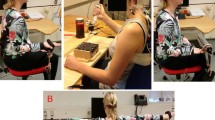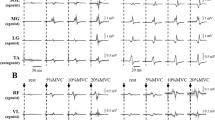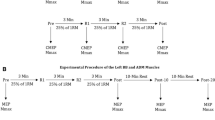Abstract
The aim of the study was to examine the effect of experimental unilateral upper trapezius muscle pain on the relative activation of trapezius muscle subdivisions bilaterally during repetitive movement of the upper limb. Surface EMG signals were detected from nine healthy subjects from the upper, middle and lower divisions of trapezius during a repetitive bilateral shoulder flexion task. Measurements were performed before and after injection of 0.5 ml hypertonic (pain condition) and isotonic (control) saline into the upper division of the right trapezius muscle in two experimental sessions. On the painful side, upper trapezius showed decreased EMG amplitude (average rectified value, ARV) and lower trapezius increased ARV throughout the entire task following the injection of hypertonic saline (40.0 ± 22.2 vs. 26.0 ± 17.4 μV, and 12.5 ± 7.6 vs. 25.6 ± 14.8 μV, respectively, at the beginning of the contraction). On the side contralateral to pain, greater estimates of ARV were identified for the upper division of trapezius as the task progressed (37.4 ± 20.2 vs. 52.7 ± 28.4 μV, at the end of the contraction). Muscle fiber conduction velocity did not change with pain in all three divisions of the right trapezius muscle. The results suggest that local elicitation of nociceptive afferents in the upper division of the trapezius induces reorganization in the coordinated activity of the three subdivisions of the trapezius in repetitive dynamic tasks.






Similar content being viewed by others
References
Ciubotariu A, Arendt-Nielsen L, Graven-Nielsen T (2004) The influence of muscle pain and fatigue on the activity of synergistic muscles of the leg. Eur J App Physiol 91:604–614
Cools AM, Witvrouw EE, Declercq GA, Danneels LA, Cambier DC (2003) Scapular muscle recruitment patterns: trapezius muscle latency with and without impingement syndrome. Am J Sports Med 31:542–549
Elert J, Kendall SA, Larsson B, Mansson B, Gerdle B (2001) Chronic pain and difficulty in relaxing postural muscles in patients with fibromyalgia and chronic whiplash associated disorders. J Rheumatol 28:1361–1368
Ervilha UF, Farina D, Arendt-Nielsen L, Graven-Nielsen T (2005) Experimental muscle pain changes motor control strategies during dynamic fatiguing contractions. Exp Brain Res 164:215–224
Falla D, Farina D (2005) Muscle fiber conduction velocity of the upper trapezius muscle during dynamic contraction of the upper limb in patients with chronic neck pain. Pain 116:138–145
Falla D, Bilenkij G, Jull G (2004) Patients with chronic neck pain demonstrate altered patterns of muscle activation during performance of a functional upper limb task. Spine 29:1436–1440
Falla D, Farina D, Graven Nielsen T (2006) Spatial dependency of trapezius muscle activity during repetitive shoulder flexion. J Electromyogr Kinesiol (in press)
Farina D, Arendt-Nielsen L, Merletti R, Graven-Nielsen T (2004a) Effect of experimental muscle pain on motor unit firing rate and conduction velocity. J Neurophysiol 91:1250–1259
Farina D, Pozzo M, Merlo E, Bottin A, Merletti R (2004b) Assessment of average muscle fiber conduction velocity from surface EMG signals during fatiguing dynamic contractions. IEEE Trans Biomed Eng 51:1383–1393
Ge HY, Arendt-Nielsen L, Farina D, Madeleine P (2005) Gender-specific differences in electromyographic changes and perceived pain induced by experimental muscle pain during sustained contractions of the upper trapezius muscle. Muscle Nerve 32:726–733
Graven-Nielsen T, Svensson P, Arendt-Nielsen L (1997) Effects of experimental muscle pain on muscle activity and co-ordination during static and dynamic motor function. Electroencephalogr Clin Neurophysiol 105:156–164
Graven-Nielsen T, Lund H, Arendt-Nielsen L, Danneskiold-Samsoe B, Bliddal H (2002) Inhibition of maximal voluntary contraction force by experimental muscle pain: a centrally mediated mechanism. Muscle Nerve 26:708–712
Hermens HJ, Freriks B, Merletti R, Stegemen D, Blok J, Rau G, Disselhorst-Klug C, Hägg G (1999) European recommendations for surface electromyography. Roessingh Research and Development, The Netherlands
Jensen C, Vasseljen O, Westgaard RH (1993) The influence of electrode position on bipolar surface electromyogram recordings of the upper trapezius muscle. Eur J Appl Physiol Occup Physiol 67:266–273
Johnson GR, Pandyan AD (2005) The activity in the three regions of the trapezius under controlled loading conditions—an experimental and modelling study. Clin Biomech 20:155–161
Johnson G, Bogduk N, Nowitzke A, House D (1994) Anatomy and actions of the trapezius muscle. Clin Biomech 9:44–50
Kadi F, Waling K, Ahlgren C, Sundelin G, Holmner S, Butler-Browne GS, Thornell L (1998) Pathological mechanisms implicated in localized female trapezius myalgia. Pain 78:191–196
Larsson R, Cai H, Zhang Q, Oberg PA, Larsson SE (1998) Visualization of chronic neck-shoulder pain: Impaired microcirculation in the upper trapezius muscle in chronic cervico-brachial pain. Occup Med (Lond) 48:189–194
Le Pera D, Graven-Nielsen T, Valeriani M, Oliviero A, Di Lazzaro V, Tonali PA, Arendt-Nielsen L (2001) Inhibition of motor system excitability at cortical and spinal level by tonic muscle pain. Clin Neurophysiol 112:1633–1641
Lin J-J, Wu Y-T, Wang S-F, Chen S-Y (2005) Trapezius muscle imbalance in individuals suffering from frozen shoulder syndrome. Clin Rheumatol 24:569–575
Lindman R, Hagberg M, Angqvist K, Soderlund K, Hultman E, Thornell L (1991) Changes in muscle morphology in chronic trapezius myalgia. Scand J Work Environ Health 17:347–355
Ludewig PM, Cook TM (2000) Alterations in shoulder kinematics and associated muscle activity in people with symptoms of shoulder impingement. Phys Ther 80:276–291
Lund JP, Donga R, Widmer CG, Stohler CS (1991) The pain-adaptation model: a discussion of the relationship between chronic musculoskeletal pain and motor activity. Can J Physiol Pharmacol 69:683–694
Madeleine P, Lundager B, Voigt M, Arendt-Nielsen L (1999) Shoulder muscle co-ordination during chronic and acute experimental neck-shoulder pain. An occupational pain study. Eur J App Physiol Occup Physiol 79:127–140
Masuda T, Miyano H, Sadoyama T (1985) The position of innervation zones in the biceps brachii investigated by surface electromyography. IEEE Trans Biomed Eng 32:36–42
Masuda K, Masuda T, Sadoyama T, Inaki M, Katsuta S (1999) Changes in surface EMG parameters during static and dynamic fatiguing contractions. J Electromyogr Kinesiol 9:39–46
Mork PJ, Westgaard RH (2006) Low-amplitude trapezius activity in work and leisure and the relation to shoulder and neck pain. J Appl Physiol 100:1142–1149
Nederhand MJ, Ijzerman MJ, Hermens HJ, Baten CTM, Zilvold G (2000) Cervical muscle dysfunction in the chronic whiplash associated disorder grade II (WAD-II). Spine 25:1938–1943
Sohn MK, Graven-Nielsen T, Arendt-Nielsen L, Svensson P (2000) Inhibition of motor unit firing during experimental muscle pain in humans. Muscle Nerve 23:1219–1226
Thunberg J, Ljubisavljevic M, Djupsjobacka M, Johansson H (2002) Effects on the fusimotor-muscle spindle system induced by intramuscular injections of hypertonic saline. Exp Brain Res 142:319–326
Acknowledgments
Deborah Falla is supported by a John J. Bonica Fellowship received from the International Association for the Study of Pain and a C. J. Martin Fellowship received from the National Health and Medical Research Council of Australia (ID 351678). This study was partly supported by the Danish Technical Research Council and by the European project “Cybernetic Manufacturing Systems” (CyberManS; contract nr. 016712).
Author information
Authors and Affiliations
Corresponding author
Rights and permissions
About this article
Cite this article
Falla, D., Farina, D. & Graven-Nielsen, T. Experimental muscle pain results in reorganization of coordination among trapezius muscle subdivisions during repetitive shoulder flexion. Exp Brain Res 178, 385–393 (2007). https://doi.org/10.1007/s00221-006-0746-6
Received:
Accepted:
Published:
Issue Date:
DOI: https://doi.org/10.1007/s00221-006-0746-6




